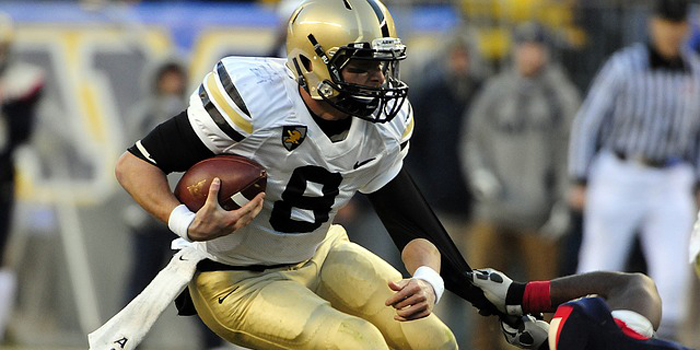
American Football is undoubtedly the most popular sport in this country. The violent, physical nature of the game played at high velocity is responsible for attracting so many viewers. It is also the reason that physical development is so imperative for football players. Football is one of the few sports that cannot be played year-round, but must be trained year-round in order to be competitive. No other sport places off-season training at such a high level.
The ultimate two goals for any off-season training program for football, or any sport for that matter, is:
- Enhance the athletic performance
- Decrease the potential injury of the athlete.
In other words, train to improve performance on the field and to stay as healthy as possible should be the main two goals of every program.
The off-season is not only a crucial period for developing players; team development is also as important. Creating a competitive culture with a tenacious work ethic in the off-season is just the beginning of improving as a team. Developing leaders within the team, ensuring accountability with teammates, and providing a setting that facilitates competition should be the cornerstones of the off-season program.
To compete at the highest level possible, coaches must commit to instituting a strength and conditioning program that will improve the overall physicality of the football program. This will not only keep a team healthier, but also enable that team to practice at a much more intense level on a more consistent basis.
Needs Analysis
Before writing any program, all coaches should conduct a needs analysis before any set, rep, or percentage should be prescribed. The two major components that need to be analyzed are the demands of the sport and the characteristics of the individual athlete. Football is one of the most physically demanding sports in this country and it is important to understand the movement patterns, the energy system utilized, and the most common injuries football players are susceptible to. Another key attribute that can further complicate this process is the number of different positions in the game of football and the variety of the demands of those positions. The second phase of a needs analysis is identifying the individual player’s training age, history of injury, movement analysis, muscular imbalances, and baseline performance testing.
Pre-Habilitation: Reducing the Potential of Injuries on the Field
There has been an exceptional amount of research recently on concussion prevention programs for athletes. The combination more stringent baseline testing and return-to-play protocols, along with more emphasis on specific training regimens, has served to protect our athletes. Head and neck training has been proven to not only reduce the chance of catastrophic head and spinal injuries; it has also been proven to reduce the chance of concussions. By strengthening the muscles that control the movement of the head, athletes are able to withstand greater forces upon impact during a game or practice.
Although ACL injuries can be eight times more likely in female athletes, ACL prevention protocols can help reduce the chance of not only ACL and other related knee injuries but also reduce the occurrence of hamstring pulls (tears) and all other non-contact lower extremity injuries. Coaches can incorporate specific exercises such as posterior chain exercises to address glute and hamstring weakness, hip abduction to reduce knee valgus and internal rotation of the knee, and drills for neuromuscular control.
Wear and tear on the entire shoulder girdle is a forgone conclusion in the game of football. One method of reducing the chance of shoulder injuries is to address muscular imbalances, specifically addressing weakness in the upper back, posterior shoulder girdle by way of increasing scapular retraction and external rotation.
Photo courtesy Denison University Sports Information
Force Training and Armor Building
Strength training has multiple benefits for a football player. The two most obvious are increasing maximal strength and increasing muscular hypertrophy; both are imperative for football players at every position. Organizing strength training by movements and not muscles can assist in developing the overall player and curtail muscular imbalances that can lead indirectly to injuries. By creating an exercise pool, we characterize strength lifts into four variations for upper and lower body. These categories include:
- Double Leg Push (Knee Dominant)
- Double Leg Pull (Hip Dominant)
- Single Leg Push
- Single Leg Pull
- Horizontal Push
- Horizontal Pull
- Vertical Push
- Vertical Pull
Training for maximal strength can improve a player’s performance. Consequently, increasing muscle mass, or Armor Building as coach Dan John states, can help football players withstand the physical nature of the game.
The game of football undoubtedly has the longest off-season of any sport, especially at the high school and small college level. This, combined with the physical demands and violent nature, places off-season training in the highest priority. Dr. Mel Siff and Yuri Verkoshansky in the book Supertraining have divided training into two preparatory phases: General Physical Preparation and Specific Physical Preparation. James "The Thinker" Smith has been credited to adding the term General-Specific Preparation to bridge the gap between the two. Here is a look of what specific exercises and drills fit into what category for the game of football.
Mobility and Flexibility
There are three different times in a typical training session to accomplish better mobility and flexibility. The first is usually a dynamic warm-up routine at the beginning of the session. The second method can be some sort of soft-tissue work such as myofascial release using a foam roller, stick, PVC pipe, or ball. This can be done both before and after a workout. The last and most common method would be some variation of static stretching. Typically this is done at the conclusion of a training session and can have several categories such as active, passive, and proprioceptive neuromuscular facilitation stretching.
Linear Speed and Acceleration
Unless you have never watched football, it is obvious that speed is one of the most sought-after qualities for a football player regardless of position. The ability to cover as much of the field in the shortest time possible is just one of the many advantages of possessing speed on the football field. Linear speed is defined by a very simple formula: Stride Length x Stride Frequency. In other words, the more ground you cover on each step and the more steps you can take in a given time, the better. As coach Buddy Morris has stated stride length is a bi-product of speed and not the reverse. A positive fact about speed training is stride length is a more trainable quality than stride frequency. This half of the equation is enhanced by improved anterior chain flexibility and increased posterior chain and torso strength. Basically, the more force you apply to the ground, the more ground you will cover. Strength = Speed.
Speed Mechanics
There are three basic areas we address: posture, arm action and leg action. Posture is simply addressed by having the athlete execute a forward lean without breaking posture, especially at the hips. With arm action, athletes should keep the elbow locked and move at the shoulder joint by pushing the elbows back. Finally, leg action is divided into front-side mechanics and back-side mechanics. An integral part of front side mechanics is triple flexion of the hip, knee, and ankle joints. Triple extension in the hip, knee, and ankle joints involves how the back leg strikes the ground with the most optimal force. Front side mechanics are highly dependent on flexibility, whereas backside mechanics are dependent on strength.

Sprints
It is very rare for a football player, regardless of position, to reach top-end velocity during an actual game. The game of football is rarely played while running in a straight line for longer distances. For this reason, it is advisable to train football players in the 10 to 40 yard range. The latter distance is usually synonymous with performance due to combine testing.
As a general rule, if an athlete is not running at full speed, they are not developing speed. An athlete sprinting at less than full-speed is usually not attributed to effort, but rather fatigue due to condensed rest intervals or inappropriate volume.
Determining rest intervals can be as simple as understanding the applicable work to rest ratio. We have adapted a formula from Charlie Francis for non-track athletes. Normally, at least 30 seconds of rest for each second a sprint lasts. For example, if an athlete is sprinting a 40 yard dash in approximately 5 seconds; that rest interval should be about two and a half minutes. Total volume should usually be about 200-300 yards for all combined sprints. Here is an example for a typical session:
Specific Volume can be adjusted by position or in an auto-regulatory fashion. One idea that I learned from Martin Rooney was to base the volume of sprints on performance. This concept would provide a "cut-off" point on sprints once the athlete's time becomes slower.
Lateral Speed and Agility
The ability to move laterally and change direction is imperative for any football player regardless of position. The combination of being able to explosively brake, change direction, and accelerate defines agility on the football field. There are many factors that contribute to agility. Strength, mechanics, reaction time, and balance are just a few of the many qualities that enhance agility. The most trainable qualities from a coaching standpoint are mechanics and strength.
Change of Direction Mechanics
Changing direction is a teachable skill that football players need to work hard at during the off-season. Having a basic and fundamental understanding of how the athlete should decelerate by using proper posture, changing the center of gravity, correct foot placement is all extremely important.
Relative Strength
Lack of lower body and core strength can be detrimental to a football player for obvious reasons. More specifically, lack of strength can negatively affect an athlete’s ability to effectively change direction. There is an estimated 2-8 times an athlete’s bodyweight which is applied when changing direction at full speed.
This is why absolute strength is vitally important for football players even on non-contact plays. It is imperative that the athlete not only posses enough yielding strength to stop their momentum while maintaining good posture, but also have the inter-muscular coordination to recruit the proper motor units in the correct sequences. Muscular imbalances can be as detrimental to COD mechanics as lack of overall strength, specifically in the posterior chain and torso.
Conditioning
Depending on the team, game situation, and level the game is played at, the average football play is around four to eight seconds with approximately 25-35 seconds rest between plays. It is important that football teams are conditioned to perform at the highest level specifically to this ratio. The off-season is an optimum time to develop a larger range of these energy systems for more comprehensive development.
Although football is generally believed to be an alactic sport, because of the evolution of the no-huddle/spread offense, the speed of the game has increased. Rest intervals between plays are diminishing and lactic acid (fast glyocolysis) energy systems are more relevant. The gap between ATP-PC and the aerobic energy systems is closing in football. It is also the author’s belief for teams to train in all of these energy systems during different times in the off-season.
When teams like the University of Oregon snaps the ball every 16 seconds, offenses stretch the defenses horizontally as well as vertically, and any rest between plays is done by running back to receive the call from the sidelines. The game of football is different now.
There are two crucial points that I want to reiterate on off-season conditioning. These points are where I will undoubtedly receive the most disagreement. Due to 13 years of college football coaching experience, I may have a different perspective on conditioning than a strength-only coach. It is my personal belief that:
- The purpose of off-season (winter, spring, or summer) training is not to prepare the athlete for the game of football but for fall football camp. With offenses running two huddles at one defense, simultaneous team sessions, and special teams circuits in every practice, the rigors of camps exceed the physical demands of in-season practices.
- It takes no talent to be in shape for football. Not being prepared for camp means an increase in injuries during that time.
- It is inadvisable for a coach to train at the intensity of a drill like Repeat-40s early in the training session. A funnel down approach with training volume of conditioning (usually 600 total yards) with descending work to rest ratios is advisable. This combined with an inverse relationship with sprint distances over time is ideal.
- The goal for any coach concerning conditioning should mean the least effective dose in order to accomplish the fitness goal. How can we get the athlete in the best conditioning for his sport while minimizing ground contacts throughout training?
The Off-Season Training Session
Below is a typical training session for the off-season. There are three basic time blocks which include pre-lift, lift, and post-lift segments. More specifically, they are broken into these groups:
- Pre-Lift Circuit 1 (5 min)
- Pre-Lift Circuit 2 (5 min)
- Pre-Lift Circuit 3 (10 min)
- Reactive Method (10-15 min)
- Force Training (25-30 min)
- Commitments (10 min)
Pre-Lift Circuits
Soft Tissue Work (Self MyoFascial Release)
The problem with having enough foam rollers at your facility to accommodate all of your athletes is storage and progressions. This is one of the reasons we would use multiple implements for addressing tissue quality in a circuit fashion. A typical three station rotation would look something like this:
Pre-Lift Circuit 1
Movement Prep (Two Sets of Hurdles/30 seconds per mobility station)
Our movement prep would consist of a hurdle drill coupled with a mobility exercise. We would typically focus on hip, ankle, and thoracic spine mobility. This eight station rotation would address log-jams and keep athletes active. On some occasions we would do a modified version of the Parisi Warm-Up.
Pre-Lift Circuit 2
Pre-Habilitation
The term pre-hab may be overused in our industry. Coaches understand that they cannot prevent injuries but rather reduce the risk of those injuries from happening. Specifically non-contact soft-tissue injures. We would try to give our athletes equipment based circuits to address key areas of concern while providing some autonomy with specific drills within the template. The advantage was that we could utilize as much space and equipment as possible to allow for an expedited training environment. The four areas we would focus on included:
- Head and Neck
- Posterior Shoulder Girdle
- Torso
- Posterior Chain and VMO
This template allows for five different groups to perform similar movements with multiple equipment. Daily rotation should be schedule to allow athletes to address all components of the overall template.
Pre-Lift Circuit 3
Warm-Up Before MDSAP Sessions
The warm-up before multi-directional speed, agility, and plyometric sessions will be more specific to the training session for obvious reasons. The first two sections will cover about five yards, dynamic flexibility between 10-20 yards, with the last section between 20-40 yards (5-15 yard bound with 15-30 yard sprint).
 Incorporating some plyometirc drills within the warm-up significantly reduced the amount of lower-extremity soft-tissue injuries during speed and practice sessions.
Incorporating some plyometirc drills within the warm-up significantly reduced the amount of lower-extremity soft-tissue injuries during speed and practice sessions.
Warm-Up Complexes for Olympic Lifts
Using warm-up sets of olympic lifts to reinforce squatting patterns is a concept we would implement. This would allow our athletes to perform squats at least three days per week to reinforce proper motor patterns.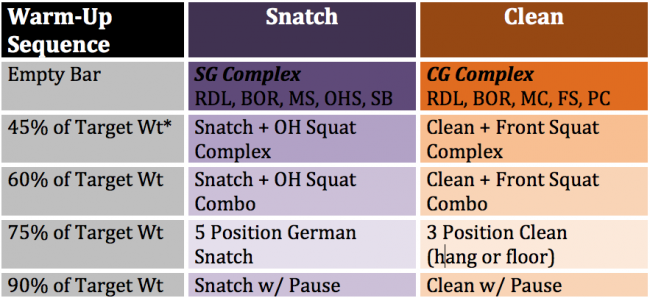
Auto-Regulatory Parameters
There are two separate methods we would use to auto-regulate the training sessions during the off-season. They involve adjusting the training load by rep performance and adjusting the volume of the exercise by the load parameters.
Adjusting Load by Rep Performance
This method is often utilized during the first week of a training cycle or the first week after a deload, depending on your program. This particular example would allow the athlete to accurately find a rep max while still accumulating volume within the session. The load for each set is based of the repetition performance of the previous set.
Adjusting Volume by Load Parameters
This particular example is more commonly utilized on a week to week basis during a linear or non-linear periodization scheme. In this case, the athlete will adjust the subsequent sets by the rep performance of the max set. In collegiate athletes, a two-rep drop off was standard and provided the best opportunity to auto-regulate based on anecdotal evidence. The training age of most college athletes were lower than competitive lifters, although some more advanced athletes could incorporate a one-rep drop-off utilizing the same system.
Basically, if an athlete was short one rep of his percentage-based rep max, he was training at a percentage higher than what was prescribed. This system allowed for reduced or increased volume that would follow closer to Prilepin's parameters.
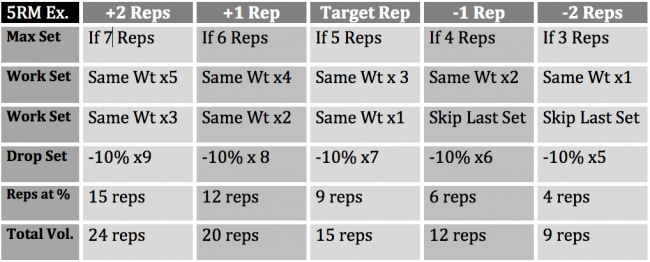 For a more detailed look at auto-regulatory training, there are more concepts listed in this article.
For a more detailed look at auto-regulatory training, there are more concepts listed in this article.
8 Week Off-Season Training for Football
Week 1
Week 1: Monday AM
In-place/ Linear Plyometrics*
Pogo Jumps
Vertical Jumps
Squat Jumps
x 10 each
Agility (COD)
4 Cone Drills#
I, N, X (4) each
Speed (Acceleration)
(6) 10s w/ 30s RI
(6) 20s w/ 60s RI
Conditioning
Super Gassers x2
55/60/66(Target times)
Week 1 : Monday PM
Pause Hang Clean
80%x5x3
Batwing Plate RDL x 50 reps
Glute-Ham Raise
50 reps
Single Leg Pull Circuit (choose 1):
- SL Band RDL x50 reps
- Band TKEs 2x25
- SL Plate RDL - 55, 45, 35, 25 x10
- OH Walking Plate Lunge 55, 45, 35, 25 x5
- SL RDL ( 1DB) - 3 x 8-12
- Goblet RFE Split Squat 2x10
- SL RDL (2 DBs) - 3 x 8-12
- DB Reverse Lunge 2x10
Week 1: Tuesday
BB Hang Snatch
85%x5x3
Bench Press
80% x8,6,4,(-10%x10)
Underhand Grip Chin-Up
Ladder -10 sets
Incline DB Press 2x10-15
Chest Supported DB Row
100 reps of (choose one):
- Up-the Rack Push-Up
- Suspended Push-Up
- Stability Ball Push-Up
- Med Ball Push-Up
- Chain Push-Up
- Band Push-Up
- DB Incline Push-Up
- Partner Push-up
Supersetted With
100 reps of (choose one):
- Blast Strap Row
- 1 Arm Blast Strap Row
- Band Row
- 1 Arm Band Pull-Down
- Diesel Row w/ Chains
- Flexed Arm Hang
- Inverted Rack Row
- Manual Resistance Towel Row
Week 1: Thursday
Box Jump
(10-15 jumps)
Prone Starts
(10) 10s w/ 30s RI
Back Squat
80% x8,6,4,(-10%x10)
Glute-Ham Raise
50 reps
SL Plate RDL
25, 35, 45, 55 x10
Week 1: Friday
Fat Gripz DB Clean & Press:
Max reps for time
DB Bench Press
40% of Body weight for 1min, 45sec, 30 sec
Choose 1 exercise for 3 sets of 10-15:
- 1 Arm DB Row
- 1 Arm KB Row from Floor
- Renegade Row
- Diesel Row w/ Chains
Choose 1 for 20-30 total reps:
- 1-2-3-4 Board Press
- Swiss Bar 4-Grip Bench Press
- Mini-Band Stability Press
- Stability Ball Press - 25% of BW for 1min, 45sec, 30 sec
Conditioning Circuit (Varied)
Prowler Push
Relays, Ropes,
Sledgehammers,
Wall-Walks
Week 2
Monday AM
In-Place/ Linear Plyometrics
Pogo Jumps
Vertical Jumps
Squat Jumps
Tuck Jumps
x 10 each
Agility (COD)
40-yard Shuttle, 5 back, 10 back, sprint 10
Linear Speed
(2) 10s w/ 30s RI
(2) 20s w/ 60s RI (4)
30s w/ 90s RI
Conditioning
300yd Shuttles x2
60/66/72
Week 2: Monday PM
Halting Clean
85%x10x1
Barbell RDL
80%x8 6, -10% x10
Weighted Glute-Ham Raise
40 reps
Single Leg Pull Circuit (Choose 1)
- SL Band RDL x50 reps
- Band TKEs 2x25
- SL Plate RDL — 55, 45, 35, 25 x10
- OH Walking Plate Lunge 55, 45, 35, 25 x5
- SL RDL (1DB) — 3 x 8-12
- Goblet RFE Split Squat 2x10
- SL RDL (2 DBs) — 3 x 8-12
- DB Reverse Lunge 2x10
Week 2: Tuesday
Barbell Snatch from Blocks
88%x8x2
Bench Press
85% x6,4,2,(-10%x8)
Wide Overhand Grip Pull-Up
Ladder -10 sets
Incline DB Alternating Press 2x10-15
Head Supported DB Row 2x10-15
100 reps of (choose one):
- Up-The Rack Push-Up
- Suspended Push-Up
- Stability Ball Push-Up
- Med Ball Push-Up
- Chain Push-Up
- Band Push-Up
- DB Incline Push-Up
- Partner Push-up
Supersetted With
100 reps of (choose one):
- Blast Strap Row
- 1 Arm Blast Strap Row
- Band Row
- 1 Arm Band Pull-Down
- Diesel Row w/ Chains
- Flexed Arm Hang
- Inverted Rack Row
- Manual Resistance Towel Row
Week 2: Thursday
Box Jump
(15-20 jumps)
Back Squat
85% x6,4,2,(-10%x8)
Supine Starts
(6) 10s w/ 30s RI
(4) 15s w/ 45s RI
Glute-Ham Raise
Weighted 40 reps
SL RDL (1DB)
3 x 8-12
Week 2: Friday
Atlas Stone over Bar:
Max reps for time
BB OH Press
85% x5,3,2,(-10%x8)
Choose 1 exercise for 3 sets of 10-15:
- 1 Arm DB Row
- 1 Arm KB Row from Floor
- Renegade Row
- Diesel Row w/ Chains
Choose 1 for 20-30 total reps:
- 1-2-3-4 Board Press
- Swiss Bar 4-Grip Bench Press
- Mini-Band Stability Press
- Stability Ball Press - 25% of BW for 1 min, 45sec, 30 sec
Conditioning Circuit (Varied)
- Prowler Push
- Relays, Ropes,
- Sledgehammers
- Wall-Walks
Week 3
Week 3: Monday AM
In-Place/ Linear Plyometrics
Stair Hops
Stair Jumps
Stair Depth Jumps
X8 each
Agility (COD)
3 Cone Drill x 4 per side
Speed (Acceleration)
(2) 10s w/ 30s RI
(2) 20s w/ 60s RI (3)
30s w/ 90s RI
(3) 40s w/ 2m RI
Conditioning
Gassers x 3
36/40/44/48
Week 3: Monday PM
Hang Clean
85%x4x4
Trap Bar Deadlift
88%x 5,3,2
Eccentric Loaded Glute-Ham Raise
30 reps
Single Leg Pull Circuit (choose 1):
- SL Band RDL x50 reps
- Band TKEs 2x25
- SL Plate RDL - 55, 45, 35, 25 x10
- OH Walking Plate Lunge 55, 45, 35, 25 x5
- SL RDL (1DB) - 3 x 8-12
- Goblet RFE Split Squat 2x10
- SL RDL (2 DBs) - 3 x 8-12
- DB Reverse Lunge 2x10
Week 3: Tuesday
Barbell Snatch from Floor
90%x10x1
Bench Press
90% x4,3,2,1,(-10%x6)
Neutral Grip Pull-Up
Ladder — 10 sets
Incline DB Duo Press 2x10-15
Chest Supported DB Row 2x10-15
100 reps of (choose one):
- Up-The Rack Push-Up
- Suspended Push-Up
- Stability Ball Push-Up
- Med Ball Push-Up
- Chain Push-Up
- Band Push-Up
- DB Incline Push-Up
- Partner Push-up
Supersetted With
100 reps of (choose one):
- Blast Strap Row
- 1 Arm Blast Strap Row
- Band Row
- 1 Arm Band Pull-Down
- Diesel Row w/ Chains
- Flexed Arm Hang
- Inverted Rack Row
- Manual Resistance Towel Row
Week 3: Thursday
Box Jump
(10 jumps)
Depth Jump
(12-15 jumps)
Kneeling Starts
(6) 10s w/ 30s RI
(4) 15s w/ 45s RI
Back Squat
90% x4,3,2,1,(-10%x6)
Eccentric Loaded Glute-Ham Raise
30 reps
SL RDL (2 DBs)
3 x 8-12
Week 3: Friday
Axle Clean & Press:
max reps for time
185/205/225 Bench Rep Test
Choose 1 exercise for 3 sets of 10-15:
- 1 Arm DB Row
- 1 Arm KB Row from Floor
- Renegade Row
- Diesel Row w/ Chains
Choose 1 for 20-30 total reps:
- 1-2-3-4 Board Press
- Swiss Bar 4-Grip Bench Press
- Mini-Band Stability Press
- Stability Ball Press - 25% of BW for 1min, 45sec, 30 sec
Conditioning Circuit (Varied)
Prowler Push
Relays, Ropes,
Sledgehammers
Wall-Walks
Week 4
Week 4: Monday AM
Lateral Plyometrics
Skater Jumps
Band Resisted Skater Jumps
x6 each
Agility (COD)
Pro Agility 5-10-5
Testing x 5 each side
Speed (Acceleration)
(6) 10s w/ 30s RI
(8) 20s w/ 60s RI
Conditioning
15-yard Shuttles x 4
33/36/39
Week 4: Monday PM
Clean from Rack
80%x8x2
Barbell RDL
83%x7,5,-10%x9
Glute-Ham Raise
40 reps
Single Leg Pull Circuit (Choose 1)
- SL Band RDL x50 reps
- Band TKEs 2x25
- SL Plate RDL - 55, 45, 35, 25 x10
- OH Walking Plate Lunge 55, 45, 35, 25 x5
- SL RDL (1DB) - 3 x 8-12
- Goblet RFE Split Squat 2x10
- SL RDL (2 DBs) - 3 x 8-12
- DB Reverse Lunge 2x10
Week 4: Tuesday
1 Arm DB Snatch
88%x4x4
Fat Bar Bench Press
85%x5,3,2 -10% Board Press x max reps
Fat Grip Pull-Up
Ladder -10 sets
Incline DB Press
Chest Supported DB Row
100 reps of (choose one):
- Up-The Rack Push-Up
- Suspended Push-Up
- Stability Ball Push-Up
- Med Ball Push-Up
- Chain Push-Up
- Band Push-Up
- DB Incline Push-Up
- Partner Push-up
Supersetted With
100 reps of (choose one):
- Blast Strap Row
- 1 Arm Blast Strap Row
- Band Row
- 1 Arm Band Pull-Down
- Diesel Row w/ Chains
- Flexed Arm Hang
- Inverted Rack Row
- Manual Resistance Towel Row
Week 4: Thursday
Box Squat w/Bands 8x2 w/60%
Seated Box Jump
(20 jumps)
Parallel Starts
(4) 10s w/ 30s RI
(4) 15s w/ 45s RI
(2) 20s w/ 60s RI
Glute-Ham Raise
40 reps
SL Band RDL
50 reps
Week 4: Friday
Farmers/ Prowler Medley
Set distance for time
DB Push Press
90% x4,3,2,1,(-10%x6)
Choose 1 exercise for 3 sets of 10-15:
- 1 Arm DB Row
- 1 Arm KB Row from Floor
- Renegade Row
- Diesel Row w/ Chains
Choose 1 for 20-30 total reps:
- 1-2-3-4 Board Press
- Swiss Bar 4-Grip Bench Press
- Mini-Band Stability Press
- Stability Ball Press - 25% of BW for 1min, 45sec, 30 sec
Conditioning Circuit (Varied)
Prowler Push
Relays, Ropes,
Sledgehammers
Wall-Walks
Week 5
Week 5: Monday AM
In-Place/Linear Plyometrics
Stair Hops
SL Stair Hops
Stair Bounds
x 4 each
Agility (COD)
4 Cone Drills
I, N, X, (4) each
Speed (Acceleration)
(2) 10s w/ 30s RI
(2) 20s w/ 60s RI
(6) 30s w/ 90s RI
Conditioning
3/4 Gassers x3
27/30/33/36
Week 5: Monday PM
Hang Clean
90%x6x3
Trap Bar DL
90%x 4,3,2,1
Glute-Ham Raise
75 reps
Single Leg Pull Circuit (choose 1)
- SL Band RDL x50 reps
- Band TKEs 2x25
- SL Plate RDL — 55, 45, 35, 25 x10
- OH Walking Plate Lunge 55, 45, 35, 25 x5
- SL RDL (1DB) - 3 x 8-12
- Goblet RFE Split Squat 2x10
- SL RDL (2 DBs) - 3 x 8-12
- DB Reverse Lunge 2x10
Week 5: Tuesday
BB Hang Snatch
88%x4x3
Bench Press
88% x5,3,2,(-10%x7)
Mixed Grip Pull-Up — 50 total reps
Incline DB Alternating Press 2x10-15
Head Supported DB Row 2x10-15
100 reps of (choose one):
- Up the Rack Push-Up
- Suspended Push-Up
- Stability Ball Push-Up
- Med Ball Push-Up
- Chain Push-Up
- Band Push-Up
- DB Incline Push-Up
- Partner Push-up
Supersetted With
100 reps of (choose one):
- Blast Strap Row
- 1 Arm Blast Strap Row
- Band Row
- 1 Arm Band Pull-Down
- Diesel Row w/ Chains
- Flexed Arm Hang
- Inverted Rack Row
- Manual Resistance Towel Row
Week 5: Thursday
Box Jump
(10 jumps)
Depth Jump
(10-15 jumps)
Back Squat
88%x5,3,2,(-10%x8)
Staggered Starts
(4) 10s w/ 30s RI
(4) 15s w/ 45s RI
(2) 20s w/ 60s RI
Glute-Ham Raise
75 reps
SL Plate RDL
25, 35, 45, 55 x10
Week 5: Friday
Log Clean & Press:
Max reps for time
185/205/225 Bench Rep Test
Choose 1 exercise for 3 sets of 10-15:
- 1 Arm DB Row
- 1 Arm KB Row from Floor
- Renegade Row
- Diesel Row w/ Chains
Choose 1 for 20-30 total reps:
- 1-2-3-4 Board Press
- Swiss Bar 4-Grip Bench Press
- Mini-Band Stability Press
- Stability Ball Press (25% of BW for 1 min, 45sec, 30 sec instead of reps)
Conditioning Circuit (Varied)
Prowler Push
Relays, Ropes,
Sledgehammers
Wall-Walks
Week 6
Week 6: Monday AM
Linear Plyometrics
Single Leg Sprints
10(10)10 yards x 8
Agility (COD)
40-yard shuttle, 5 back, 10 back, 10 sprint
Speed (Acceleration)
(2) 10s w/ 30s RI
(2) 20s w/ 60s RI (2)
30s w/ 90s RI
(4) 40s w/ 2m RI
Conditioning
75-yard Shuttles x 6
18/21/24
Week 6: Monday PM
Clean from Floor
90%x10x1
Barbell RDL
85%x6,4,-10%x8
Glute-Ham Raise
Weighted 60 reps
Single Leg Pull Circuit (choose 1):
- SL Band RDL x50 reps
- Band TKEs 2x25
- SL Plate RDL — 55, 45, 35, 25 x10
- OH Walking Plate Lunge 55, 45, 35, 25 x5
- SL RDL (1DB) — 3 x 8-12
- Goblet RFE Split Squat 2x10
- SL RDL (2 DBs) — 3 x 8-12
- DB Reverse Lunge 2x10
Week 6: Tuesday
Barbell Snatch from Blocks
90%x6x2
Bench Press
93% x3,2,1,1,(-10%x5)
Neutral Grip Pull-Up
4RM then 20 total reps
Incline DB Duo Press 2x10-15
Chest Supported Alternating DB Row 2x10-15
100 reps of (choose one):
- Up-The Rack Push-Up
- Suspended Push-Up
- Stability Ball Push-Up
- Med Ball Push-Up
- Chain Push-Up
- Band Push-Up
- DB Incline Push-Up
- Partner Push-up
Supersetted With
100 reps of (choose one):
- Blast Strap Row
- 1 Arm Blast Strap Row
- Band Row
- 1 Arm Band Pull-Down
- Diesel Row w/ Chains
- Flexed Arm Hang
- Inverted Rack Row
- Manual Resistance Towel Row
Week 6: Thursday
Back Squat
93% x3,2,1,1,(-10%x5)
Box Jump
(10 jumps)
SL Box Jump
(10 jumps)
Testing Starts
(4) 10s w/ 30s RI
(4) 15s w/ 45s RI
(2) 20s w/ 60s RI
Weighted Glute-Ham Raise
60 reps
SL RDL (1DB)
3 x 8-12
Week 6: Friday
Tire Flip Medley
350x2, 450x2, 550x2, 650x2 for time
BB Push Press
93% x3,2,1,(-10%x5)
Choose 1 exercise for 3 sets of 10-15:
- 1 Arm DB Row
- 1 Arm KB Row from Floor
- Renegade Row
- Diesel Row w/ Chains
Choose 1 for 20-30 total reps:
- 1-2-3-4 Board Press
- Swiss Bar 4-Grip Bench Press
- Mini-Band Stability Press
- Stability Ball Press - 25% of BW for 1min, 45sec, 30 sec
Conditioning Circuit (Varied)
Prowler Push
Relays, Ropes,
Sledgehammers
Wall-Walks
Week 7
Week 7: Monday AM
Linear Plyometrics
Power Skips
25 yards x 8
Agility (COD)
3 Cone Drill x 5 per side
Speed (Acceleration)
(6) 10s w/ 30s RI
(6) 20s w/ 60s RI
Conditioning
Half Gassers x8
18/21/24
Week 7: Monday PM
Clean from Rack
85%x8x2
Trap Bar DL
93%x 3,2,1
Eccentric Loaded Glute-Ham Raise
50 reps
Week 7: Tuesday
1 Arm DB Snatch
90%x3x3
Fat Bar Bench
Press w/ Chains
70%x 5,3,2 -10% Board Press x max reps
Wide Overhand Grip Pull-Up
3RM then 20 total reps
1 Arm Incline DB Press 2x10-15
1 Arm Chest Supported DB Row 2x10-15
Week 7: Thursday
Box Squat w/Chains 8x2 w/60%
Box Jump
(10 jumps)
SL Depth Jump
(10 jumps)
Testing Starts
(10) 10s w/ 30s RI
Eccentric Loaded Glute-Ham Raise
50 reps
SL RDL (2 DBs)
3 x 8-12
Week 7: Friday
STRONGMAN GRAND PRIX AWARDS
Dynamic Bench Press
60% x8x3 w/ Mini-Bands
Choose 1 exercise for 3 sets of 10-15:
- 1 Arm DB Row
- 1 Arm KB Row from Floor
- Renegade Row
- Diesel Row w/ Chains
NO CONDITIONING
Week 8
Week 8: Monday AM
NO JUMPS
Pro Agility 5-10-5 Testing
40-yard Sprint Testing
Week 8: Monday PM
Clean from Floor
95%x1-4RM
Week 8: Tuesday AM
Bench Press
95% x2-4RM
Cadence Chin-Up Rep Test
Week 8: Thursday
Vertical Jump Test (Vertec)
Back Squat
95%x2,1,1,(-10%x4)
Friday Medicine Ball Circuit
The typical medicine ball throw circuit would consist of approximately 40-50 throws including extension, flexion, and rotational throw drills. A standard breakdown would look something like this:
- Extension Throws: 10-15 reps
- Flexion Throws: 10-15 reps
- Rotational Throws: 20-30 reps
Further Explanation on Hypertrophy Circuits
Rep Goal
This was especially easy to implement with bodyweight exercises and provided an easy way to adjust volume by position, time of year, and sport. The goal is to give the athlete a total rep goal for an exercise. For example, with 25 glute-ham raises prescribed, athletes would be responsible for 25 reps in a few sets as possible. This is always coupled with another antagonistic exercise.
Rep Ladders
This works best with a partner or a group of three or fourth at the most. The athlete will perform a certain number of reps for the first set. Each additional set would add that same number of reps. This was a way to build volume while minimizing fatigue. To control volume, the athlete can work their way up the rep range or up and then down. Here are some examples:
- Pull-Ups 1 rep, 2 reps, 3 reps, etc.
- Blast Strap Rows 3 reps, 6 reps, 9 reps, etc.
- Push-Ups 5 reps, 10 reps, 15 reps, etc.
With this method, if a group can work up to five pull-ups and then back down to one, they would have performed 25 pull-ups.
Standardized Drop Sets
These work well for most facilities because of the abundance of plates and bumpers compared to other equipment. Basically, this is a normal drop set, but more athletes can perform these at the same time. Here are two basic examples:
- SLRDL 25kg, 20kg, 15kg, 10kg on one leg then switch
- Triceps Extension 45 pounds, 35 pounds, 25 pounds, 10 pounds
In-Season and Spring Ball
During the season and spring practices, the training cycle typically follows a more non-linear model with intensities and volume relatively standardized through-out the cycle. There will be more variety in movements incorporated during this time.









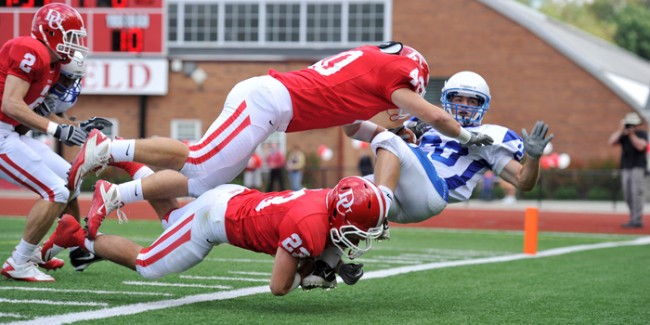

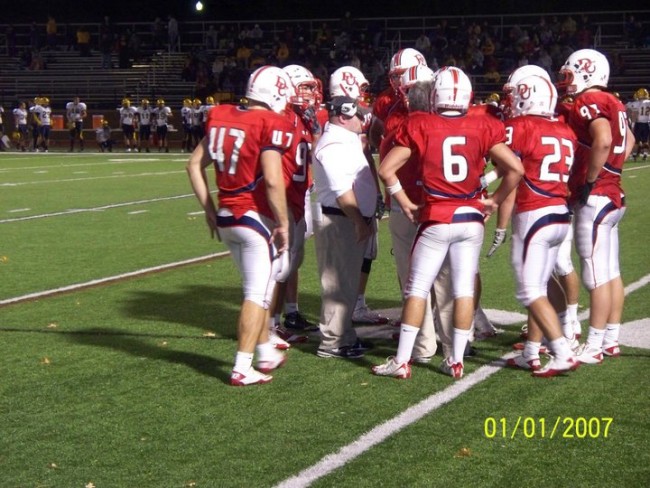
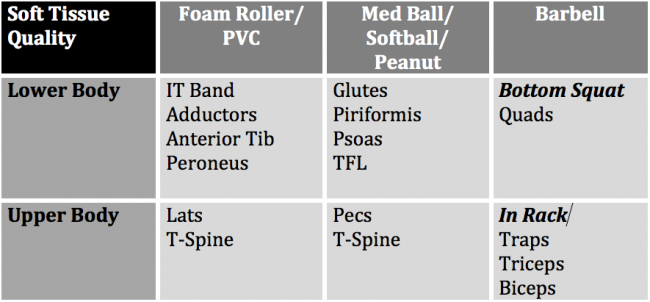
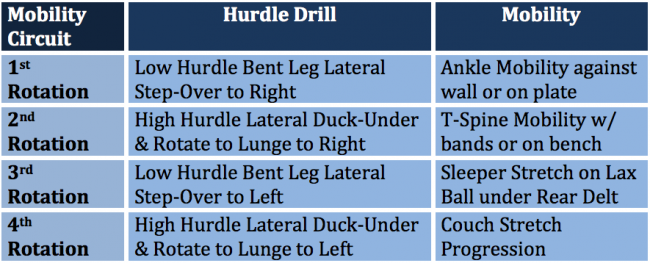
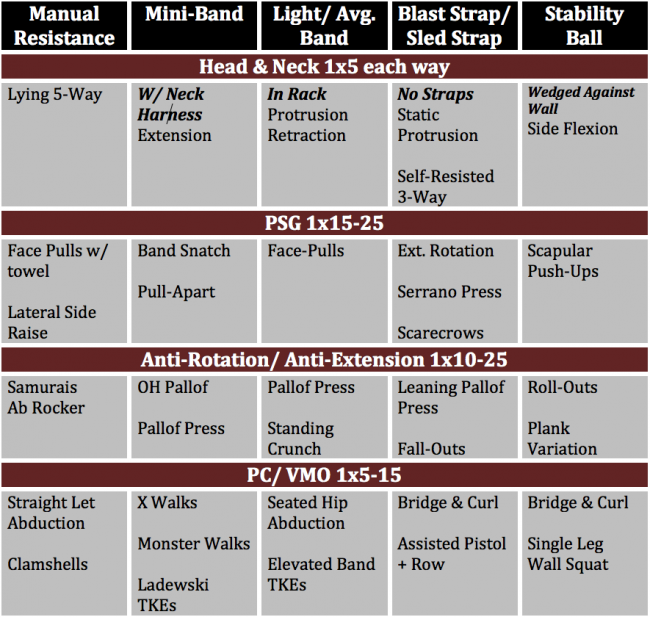
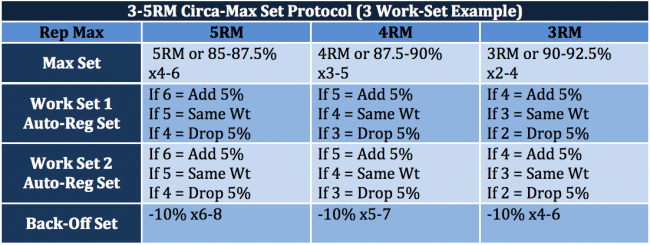
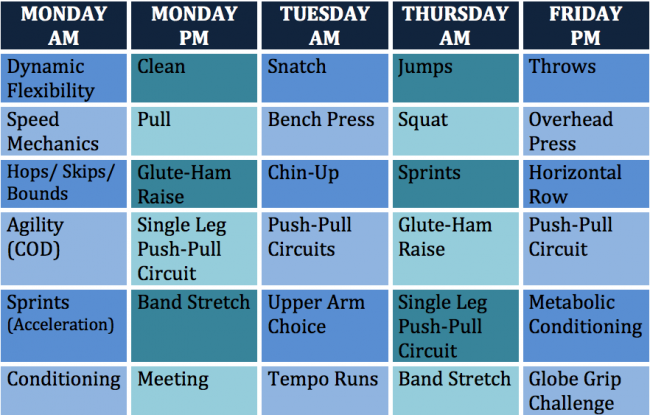
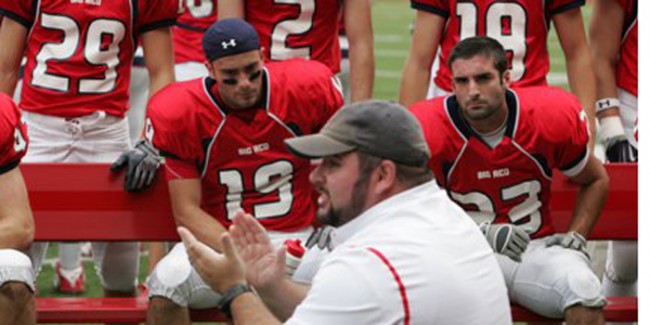
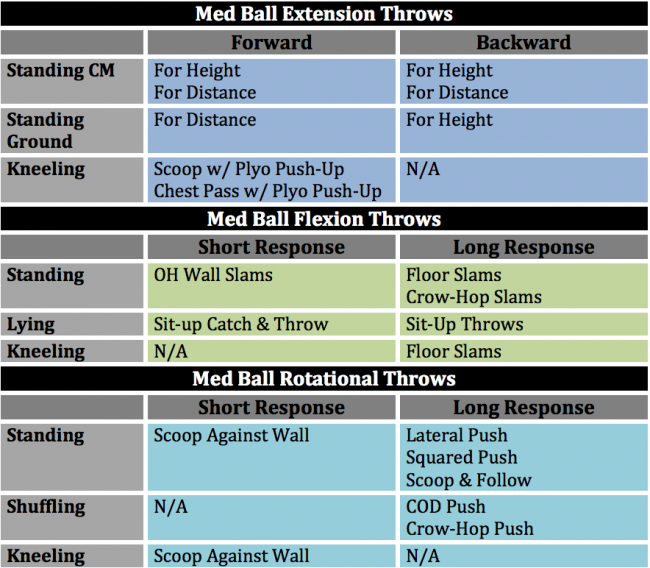

Thank you for the kind words. I really appreciate you reading this. Coming form you, it is one of the best compliments any coach could have. I hope you know how much of an influence you have been since I started reading your articles as well. Thank you.
I didn't do a very good job of explaining the circuit progression. We would generally funnel down and have a reduce volume and rest periods concurrently. Basically longer work meant longer rest. Not because this may be the best way to do this progression but because I didn't have the resources to do a 1 to 1 ratio with the same equipment with the amount of athletes. So, A typical session would be:
1. 4x1 Prowler Circuit 10yd x 4
http://www.elitefts.com/education/exercise-index/elitefts-4x1-prowler-circuit/
2. Battle Ropes x 10-20
or Sledge Hammer on a Tire x 10-20
Repeat 4-6 times
As far as recovery and tempo work. It wasn't listed in the weekly program but that would be Fartlek type tempos (track was softer thatn tennis courts) after Tuesday training. As far as off days (wed, Sat, Sun),, it was highly encouraged and they were given some ideas. A lot of guys would foam roll and band stretch on off days bu to be honest, we were at one of the top academic institutions in the country. We had an average SAT of about 1300 and we wanted those athletes to have the best opportunity to succeed.
In hindsight, would I do things differently? Well, yes. We all would when comparing our programs from 2-3 years ago. But, this wasn't just my program, it was ours (the football staff's) and although it was a phys Ed class, we all had input on the program for better or worse.
Thanks again, Mike and keep up the great work.
This was for all of our players. This was technically done during the spring between January and March. Changed the title to summer training becasue 1.( we were hoping more people would read it then, and 2.) it could be done during the summer (maybe more suited for summer, actually).
The Wide variety of exercises may be misleading. We would vary the start position on Olympic lifts and rotate between two different pulls. The Overhead presses had a lot of variation due to half of them being part of the Strong man Grand Prix. Speed work, we would vary the starts on linear speed and lateral speed work rotated between power cuts (shuttles) and speed cuts (cones). the hypertrophy work had a lot of variety on purpose (for a greater training effect.)
One thing to keep in mind is that most of the progressions leading up to the Olympic and Circa-max Effort movements. First year players spend the entire season on those progressions plus another 2 week post season period. I will admit, the in-Season for olde players look way more conjugated along with Spring ball. Most variety in exercise selections happens between positions, readiness, and mastery of those movements. I go into a little more detail about those adjustments (in-season vs off-season), playing time, etc.) in this article. I hope this helped and thank you for the questions, Michael.
http://www.elitefts.com/education/training/sports-performance/individual-training-in-a-team-setting/
Really enjoyed the article and theres a lot of good thought in it. A couple questions I had: with what exercises did you implement the auto-regulatory rep scheme? Were they done with every lift that had a %? If so, then I am assuming what you listed in your model is an example of how it played out.
Or, were the %s what you had prescribed for the players?
Thanks!
Nick
Thanks for the kind words and the more I look back at the article, the more I realize how incomplete it is. I should have done a better job of tying it all together.
The Auto-Reg Scheme was really for the Olympic and Circa-Max effort movements. Snatch, Clean, Squat, Trap Bar DL. The snatch and clean were only adjusted during week 1 and by the performance of week 8 for the next cycle. Basically, the squat, bench, and TBDL were done in this fashion.
Week 1 Adjust Load by Rep Performance within the Rep Range (Ex 1 Blue Box)
Weeks 2-3 & 5-6 Adjust Volume by Load Parameters (Ex 2 grey box)
Weeks 4 & 7 Not Adjustment
Week 8 Test (modified version of Week 1)
Basic 8 week cycle looked like: Base, Load, Re-Load, De-Load, Base, Load, De-load, Test
The Auto-Reg stuff was good, but we only adjusted maxes off the numbers of week 1. It was our version of pre-testing. The other weeks we would adjust the volume by their performance. There are definitely issues with adjusting maxes each week. We did this using the Lander Formula for a while. Here are the issues I wrote about using a true Auto-Reg system week to week:
Areas of Concern when using Auto-Regulated Sets
Because of the lower training age, reduced neurological efficiency, and the less-than-optimal inter-muscular coordination of college-aged athletes, a flat loaded system with a two-rep drop off (if the last set was truly maximum RPE) may be better. Depending on the previous set, the athlete may go up or down in weight for each subsequent set. The advantage of this is the athlete feels empowered to control the next set with each performance. This system can also breed competition among teammates (a much needed entity in team strength training). Also, the adjustments between sets are more user-friendly. Anyone can figure 10% in their head and cut that in half. There is a chance an athlete could drop weight then add or visa-versa with this system. For the adjustable weight and descending set example, a typical work set protocol could be: 300×6, 315×4, 315×3, 300×4. There will be more fluctuation in volume between athletes. Athletes being able to perform the higher reps in the range will accumulate much more volume by the end of the work sets. The advantage of this is the athletes able to perform the prescribed reps at the higher end of the range are using a lower percentage of their training maxes and the increase in volume is tolerated. Over four sets, the deviation will be no more than eight total reps.
I hope this helps a little. There are definite benefits to the auto-reg system along with things you need to work out for. What I found was the longer your athletes are in that system, the more they optimize it.
Thanks again, Nick.
Sorry, I should have explained that in more detail. The general Friday max reps for time events were part of our 6-week Strongman Grand Prix. We would split the team up into 5 equal weight classes and have one event per week up to week 6.
Week 1: 1 Arm Fat Gripz DB Clean & Press
Week 2: Atlas Stones over Bar of Time
Week 3: Fat Bar Clean & press for Time
Week 4: Farmers/ Prowler Medley for Time
Week 5: Log Clean & Press for Time
Week 6: Tire Flip Medley for Time
For the pressing events each weight class would have a set weight for the implement and would perform as many reps as possible in 75 sec (I should have just wrote that instead of for time).
In general, clean and press events were 75 and stones (or when we used to deadlift) was 60 sec.
Sorry for the confusion.
If your son is playing football for that college, the strength & conditioning coach will give him a program that the team should follow. If you want to find a facility to train at, we can help you find one that is close to you, geographically.
Thanks for reading,
Mark
Ernesto,
Thank you for the kind words (I had to use Google Translate). I wish you the best of luck in your future endeavors in training. Please let me know if there is anything else you ever need.
Sincerely,
Mark Watts
Ernesto,
Gracias por las amables palabras (tuve que usar Google Translate). Le deseo la mejor de las suertes en sus esfuerzos futuros en el entrenamiento. Por favor, avíseme si hay algo más que necesite.
Sinceramente,
Mark Watts
Super Gassers x2
55/60/66(Target times)
Does the x2 mean sets and if so does this equal out to 6 reps or am I reading this wrong